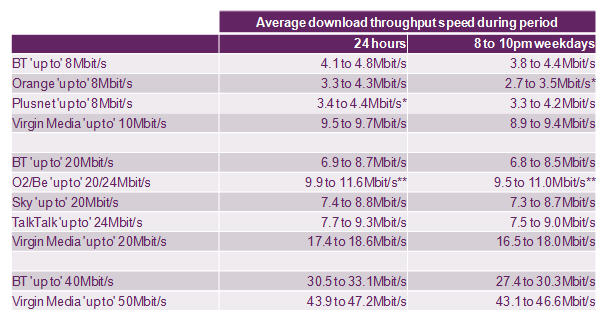The UK’s telecoms watchdog Ofcom has pointed out that average download speeds remain less than half of ‘up to’ speeds advertised by some internet service providers (ISPs), particularly for current generation copper-based ADSL services.
The research shows that the average broadband speed increased from 5.2Mbps (May 2010) to 6.2Mbps (November/December 2010) but was less than half (45pc) of the average advertised broadband speed of 13.8Mbps.
The findings came as Ofcom submitted its response to the current Committee for Advertising Practice (CAP) and Broadcast Committee for Advertising Practice (BCAP) consultation on broadband speeds advertising.
Ofcom is recommending that if speeds are used in broadband advertising, they should be based on a typical speeds range (TSR), so consumers have a clearer idea of what speeds to expect.
Ofcom also recommends that the TSR must have at least equal prominence to any maximum ‘up to’ speed, and that a maximum speed must be used only if it is actually achievable in practice by a material number of consumers.
What the next generation looks like
Ofcom also pointed out that next-generation superfast broadband services – available to a growing number of households in the UK – were significantly faster than current generation services.
Broadband services delivered by fibre-to-the-cabinet were measured for the first time and, along with cable services, delivered faster average speeds much closer to advertised speeds than was the case for current-generation broadband technologies.
The research looked at 11 packages provided by the seven largest ISPs in the market, representing more than 90pc of residential broadband subscribers in the UK. More than 18m separate service performance tests were carried out in more than 1,700 homes during November and December 2010.
These ranges reflect the speeds that would be achieved 95 times out of 100 if the exercise was repeated with different panellists. If the range of two operators overlap, then these operators offer comparable performance. They are not a description of the range of speeds actually measured.
BT Infinity experienced a fault during three days of the testing period when all panellists had their speeds capped at a maximum of 2Mbps during the weekday evening periods of 6pm-12am. The results collected during this period are: 24 hours – 29.4 to 27.7Mbps, 8-10pm weekdays – 24.3 to 27.8Mbps.
Back to copper-based ADSL services
The research showed that speeds for ADSL services over copper lines varied widely and were typically much lower than advertised speeds.
The average download speed received for ‘up to’ 20/24Mbps DSL packages was 6.2Mbps (29pc of average advertised ‘up to’ speeds).
For ‘up to’ 8Mbps DSL services, it was 3.4Mbps (42pc of average advertised ‘up to’ speeds).
Very few ADSL broadband customers achieved average actual download speeds close to advertised ‘up to’ speeds.
Just 3pc of customers on ‘up to’ 20 or 24Mbps DSL services received average download speeds of over 16Mbps, while 69pc received average download speeds of 8Mbps or less.
Fibre and cable
BT’s Infinity service, tested for the first time and currently available to 15pc of the population, also performed better than ADSL services. Average download speeds were 31.1Mbps, 78pc of the advertised speeds.
Virgin Media’s cable services, available to 48pc of the population, delivered average download speeds that were much closer to advertised ‘up to’ speeds than ADSL services, delivering between 90 and 96pc of the advertised speeds. Virgin Media’s highest speed 50Mbps package delivered an average download speed of around 46Mbps.
Download speed is typically the most common way of comparing broadband performance. However, upload speeds are also important, particularly for users that send large files, such as uploading videos and high quality photographs.
The research showed that BT’s Infinity services delivered average upload speeds of around 8Mbps – significantly higher than any other service measured in the research. Virgin Media’s ‘up to’ 50Mbps service delivered average upload speed of around 2.5Mbps while all other ISP packages delivered average upload speeds of less than 1.5Mbps.
New code urged for advertising broadband speeds
Ofcom believes a change in how broadband services are advertised is necessary to ensure that consumers can compare services effectively.
The Advertising Standards Authority (ASA) has responsibility for advertising in the UK and last year asked the CAP and BCAP (the committees which write the Advertising Codes) to conduct a review of advertising practices in the area. Their objective is to issue new guidance to the industry.
Ofcom is submitting its response to the CAP/BCAP consultation, published in January 2011, alongside this research report.
To inform its response, Ofcom conducted qualitative research, which indicated that consumers would welcome more information on broadband speeds to allow them to make effective and informed choices.
Ofcom recommends that:
- A TSR representing the range of speeds actually achieved by at least half of customers (around the median) should be used when using speeds in broadband advertising;
- If a maximum ‘up to’ speed is used in an advert, then the TSR must have at least equal prominence. The theoretical maximum ‘up to’ speed stated must also be a speed actually achievable by a material number of customers;
- Advertisers should include a qualification alerting consumers that they can confirm the likely speed that they will receive when buying their service, and, where it is the case, must also explain in the body of the advert that actual speeds depend on line quality and distance from the exchange; and
- Any reference to broadband speed in advertising (for example, words such as “fast”, “superfast” or “lightning”) must be accompanied by a TSR, which should have at least equal prominence to these words.
Below, the advertised speeds by the operators and how they actually performed in OfCom’s tests.
